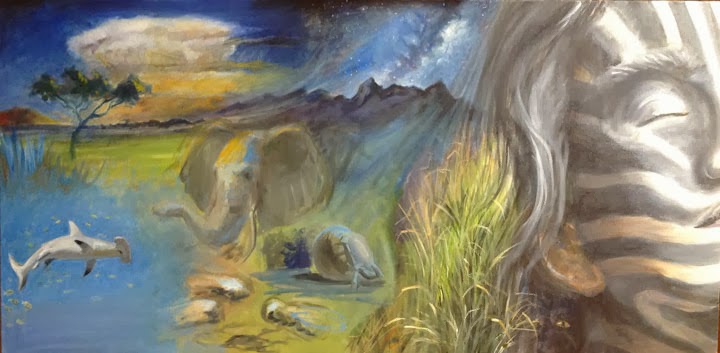The concept for the painting actually started with a thunderstorm about a dozen years ago or so while I was vacationing with my family in northern Michigan. We stay at a resort each year, where the last evening of our week's stay is punctuated by a talent show, put on by a group of willing vacationers. That particular year, one of my daughters came down with a fever so I elected to stay behind at the cottage with her, enjoying the peace of a late summer evening as the light left the sky. In the quiet, over the waves softly lapping at the shore, I heard a distant rumble as a thunderstorm made its way towards us from the far side of Lake Michigan. As it moved closer, I was reminded me of an article I had recently read that described an elephant's ability to "hear" just such a thunderstorm up to 75 miles away through the ground, sensing subsonic sound waves through the pads of its feet. For a couple of days afterwards, I continued thinking about how many other life forms around us have distinctly different senses (read Thomas Nagel's essay "What Is It Like to be a Bat" for a interesting bit on senses and how they shape one's consciousness), how we as a species have evolved and what senses we've jettisoned along the way to our current form. After all, at a specific point in time, every one of us goes through a phase in utero where we show evidence of a tail, which disappears before we are born. I toyed with the thought, turning it into a short essay called Elephant Dreaming.
Fast forward a number of years, where I am sitting around on a hot forth of July afternoon, sketching for another painting when I start playing around with an image of a female reverting back to a primitive form, replete with zebra stripes, at left below. I sketch out some other possible images before settling on a set of images that I find compelling but also relevant to this theme of lost senses.
I chose oil for this particular piece as I wanted the power of blending to make some of the images more realistic, while letting others go soft as well as the opacity of the medium. In the first image of the canvas below, I wash in the background of a fairly large (18 x 36) canvas over which I layered additional gesso and sanded fairly smooth to remove some of the tooth of the canvas. I sketched out a rough layout in graphite with a female on the right dreaming of her evolutionary past, which includes an elephant, thunderstorm, a whale and other bits to add interest. I then washed over it with a thin layer of Sienna and Burnt Umber.
After letting this layer dry, I went back at the canvas to move the elephant up to the center to become part of the mountains in the background, make the thunderstorm in the background larger and started to work up the foreground, which includes a honeycomb, and a fetus with a tail. After adding detail to the woman's face, I then set the canvas aside to work on some other pieces as I wasn't sure where to take it next.
A couple of months later, I pick up the trail again, removing the fetus (due to lack of popular demand-that's what I get for leaving the unfinished piece on an easel in the living room where everyone can comment on it in process!) as well as started reworking other parts of the elephant as I felt like the earlier version wasn't dynamic enough.
I also added two new characters, the Hammerhead Shark and the Dung Beetle both of which are empowered with some rather extraordinary senses. The Hammerhead, with its eyes spread wide has an array of sensors located along the front of its head that can detect electrical currents as little as a billionth of a volt, allowing it to detect its prey by the activity of its nervous system alone. The Dung Beetle uses the Milky Way Galaxy in the dark African sky to navigate by. So in they went. I also sketched in some bees dancing, relaying to one another a rich source of pollen, at an angle that was a bit more dynamic that a flat head-on of the honeycomb. As much as I liked the geometric appearance of its cells, it proved too distracting for the composition.
The last image shows where it stands today. The bees are starting to come together and the elephant has a more dreamlike quality while being more solid and lit from above by a hot African sun. The Dung Beetle was too centrally located, and blocked eye flow through the canvas, so he is out for now. The Zebress' head has become more refined and the highlights create more of a three-dimensional form. Will the Dung Beetle make its return? Where will it all end? Stay tuned for more updates.







No comments:
Post a Comment